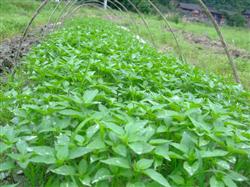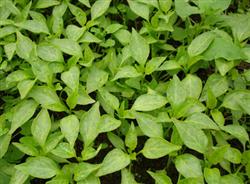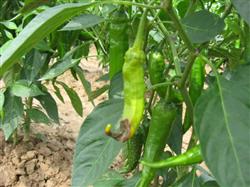What should be paid attention to in raising pepper seedlings in summer and autumn?

What should be paid attention to in raising pepper seedlings in summer and autumn? Please guide pepper seedlings in summer and autumn to pay attention to the following points: to prevent the harm of high temperature, the seedling bed should be well ventilated, sunshade should be built, sunshade should be covered with sunshade net or non-woven cloth, tree branches can also be used to shade the sun, and mud water can be sprayed on plastic film to shade the sun. After sowing, cover the seedling bed with straw and remove the seedling bed cover when 60% of the seedlings are unearthed. Through sunshade, the temperature and light transmittance are reduced, which is beneficial to the growth of seedlings. To prevent the harm of strong wind and rainstorm, the topography of the seedbed should be higher, there are drains around, and waterlogging can be discharged in time in case of heavy rain. It is best to use the "one net, one film" covering method, that is, covering the sunshade net on the plastic film, the performance of shading, cooling and rainstorm prevention is better than that of a single sunshade net. Before the rainstorm, pull down the plastic film, close the tuyere, bury it with soil all around, prevent Rain Water from flowing into the seedbed, and fix the film line to prevent it from being blown away by the strong wind. If the seedling bed into the water, so that the soil hardening, not conducive to seed germination out of soil, easy to cause a large number of dead seedlings. Before sowing to prevent the harm of drought, the seed germination rate should be tested, the sowing amount should be determined according to the test results, and the seed should be sowed or fully irrigated after pouring sufficient bottom water in the seedbed. Sowing water can not use sewage, dirty water, it is best to use groundwater. Before sowing, the seedbed should be sunshaded and moisturized. according to the weather conditions, a small amount of water can be sprayed to the seedbed in the morning or evening to prevent the seedbed from drought. The overgrowth of seedlings is mainly due to lack of light. Weak photosynthesis, less nutrients, high temperature, especially high night temperature, strong respiration, consumption of nutrients, reduce the content of dry matter in the body, coupled with sufficient nitrogen fertilizer and water, resulting in overgrowth. In addition, the seedling density is too high, block each other, lack of light, there is no ventilation in the seedling bed, less light around the seedling, only the top is exposed to more light, which promotes the rapid elongation of young stems, which will also lead to overgrowth. Therefore, the seedbed must not flood irrigation, can only use a spray can spray water, the amount of water can not be too large, keep the seedbed dry and wet, and time seedlings and sub-seedlings. As long as it does not rain, the greenhouse film should be open to facilitate ventilation, light and moisture drainage. On cloudy and rainy days, remove the sunshade net, leaving only plastic film to protect against rain and strive for more scattered light. Diseases and insect pests such as virus diseases, aphids and cabbage insects are easy to cause harm when raising seedlings in summer and autumn. Therefore, attention should be paid to the prevention of diseases and insect pests when raising seedlings. First, fertilizing should be fully mature organic fertilizer, the seedling bed should be disinfected with carbendazim or formaldehyde, and the seeds should be soaked in warm water or treated with chemicals to avoid the occurrence of soil-borne diseases. Second, after sowing, immediately spread poison bait in and around the seedbed to kill mole cricket and other underground pests. The third is to reduce the seedbed temperature in order to prevent the occurrence of virus diseases. Fourth, select disease-resistant varieties. Fifth, raise seedlings with anti-insect nets, and set up yellow and orange aphid trapping boards in the seedling bed to trap and kill aphids. Sixth, timely administration, commonly used agents are 75% chlorothalonil, 50% carbendazim, 70% mancozeb, 20% virus A, 1.5% phytopathogen EC, 50% thiram, 50% aldicarb, 50% phoxim emulsion, 80% trichlorfon and so on. Click to get more chili planting techniques click to get more vegetable planting techniques
- Prev

What do you pay attention to in raising pepper seedlings in summer and autumn?
What do you pay attention to in raising pepper seedlings in summer and autumn? Please introduce the cultivation of pepper seedlings in summer and autumn, which is easily affected by high temperature, rainy, drought and other weather, and serious seedling diseases and insect pests occur. In order to ensure the normal growth of seedlings, the following measures should be taken: first, to prevent the harm of high temperature, choose well-ventilated plots as seedbeds and build shade sheds.
- Next

How does summer chilli prevent navel rot?
How does summer chilli prevent navel rot? The symptoms of pepper umbilicus rot are similar to pepper soft rot. Pepper umbilicus rot mainly damages fruits. Dark green or dark gray water-stained spots appear at the beginning, and then expand to 2-3 cm in diameter. As the fruit develops, the diseased part is grayish brown or white...
Related
- Where is it suitable to grow horseradish in China? it is expected to see the middle altitude horseradish in Alishan.
- How to prevent tomato virus disease reasonably? (Control methods included)
- Many people like to plant towel gourd on the balcony. What are the main points of this method and management?
- What crops can chili peppers be mixed with?
- Fertilization techniques and matters needing attention in Tomato
- What are the grafting techniques for peach seedlings in spring?
- Harm and control methods of root swelling disease of Chinese cabbage
- What are the pests of sweet potatoes? How to prevent and cure it?
- Symptoms, causes and Control methods of navel Rot in Tomato
- The cause of "Cucumber rotten bibcock" in Farmers' planting Cucumber and its Control Plan

